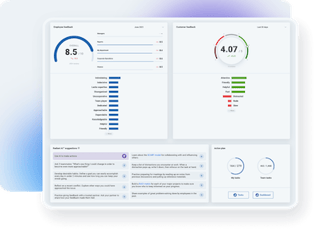
8 Ways to Keep Remote Employees Engaged
The workplace is becoming increasingly dispersed, with the number of remote employees growing in many companies. In a recent survey, 63 percent of company managers said they already have a remote employee on their team, and 38 percent said they expect their team to be predominately remote by 2028.
There is evidence that working remotely has a positive effect on engagement. Gallup research found that employees who spend at least some of their time working remotely have higher engagement levels than those who don't ever work remotely. However, keeping remote employees engaged requires paying careful attention to team interactions, communication, and opportunities for recognition.
Here are eight ways to keep remote employees engaged:
Ask Them for Feedback
The key to keeping remote employees engaged is understanding their experience with their work and with others. Employee feedback delivers insight regarding which aspects of work life are rewarding, which are frustrating, and which need to change in some way. Some remote employees may desire a better experience with their team, while others may need more or different resources to be effective. You won’t know there are issues holding remote employees back from performing at their best unless you ask.
When you ask for feedback, you show you care and are committed to keeping your employees engaged. By asking for feedback, you also allow remote employees to offer suggestions for how to make their work experience more rewarding, and what kind of process or policy changes can better support their effectiveness.
Provide Opportunities to Bond
For remote employees and their counterparts in the office, it can be tough to get to know one another and bond with limited face-to-face contact, but working remote shouldn’t mean working alone. Positive interactions with coworkers are powerful drivers of engagement, especially for remote workers.
By interacting with others, even on topics that aren’t directly work-related, remote employees have a chance to build stronger relationships and develop a sense of team. Some examples of activities that provide bonding opportunities for remote employees include:
- Occasional face-to-face off-site or team-building outings
- Virtual meetings and team lunches
- Frequent telephone check-ins
- Mentorship programs that pair a remote employee with a non-remote employee
Let Them Lead
A Harvard Business Review survey found that remote employees often feel left out and that their non-remote coworkers make changes to key projects without involving them. Sometimes, being physically present when an impromptu discussion takes place is all it takes to feel included, but remote employees often don’t have that option. They are often in the unfortunate position of finding out about changes to a key process or project at the last minute rather than knowing about them in advance.
One way to keep remote employees from feeling left out is to formally put them “in.” In leading a project or team, they are automatically at the center of day-to-day happenings and less likely to be or feel left out. From a position of leadership, they are more likely to play a pivotal role in key conversations and be aware of changes and updates as they occur.
Increase Communication
Effective communication is critical to the success of any initiative or work project. It is also an important driver of engagement that helps build trust and improve interactions between employees. Healthy communication draws out ideas and questions, and it also drives a deeper understanding of key goals to ensure everyone stays on track. However, communication can be more challenging for remote employees because a good chunk of work communication still happens face to face.
Remote employees must rely on phone and email communication to a greater degree than on-site employees. Those communication methods certainly have their place, but they don’t allow remote employees to pick up on important nonverbal cues such as eye contact or body language. You can increase opportunities for communication with remote employees by holding team meetings with video capability, having frequent one-to-one conversations, and following up on team emails with an offer for further conversation via video conference, chat, or document sharing.
Recognize Their Effort and Results
Remote employees don’t have the benefit of demonstrating how hard they work to the rest of the office. Much or all of their daily work activities go largely unseen, and this can create pressure to work more and ultimately burn out. One study found that remote employees were more likely to work longer hours beyond a typical workday and put in more effort than needed. However, putting in all that extra effort can backfire if no one acknowledges the effort or the result.
Remote employees benefit from recognition just as other employees do. In fact, research by Aon found that recognition was the top driver of engagement among surveyed employees. You can keep remote employees engaged by encouraging regular manager recognition (for example, with a thank-you note, team shoutout, or small gift). Recognition can also be in the form of valuable feedback from teammates, coworkers on other teams, and senior leaders in the company.
Implement Collaboration Technology
Technology makes remote work possible in many ways. It can be used to keep remote employees engaged because it enables more ways to communicate and collaborate with others. Collaboration technology doesn’t just give remote employees a way to stay in the loop and provide input on key projects. It also provides more ways for employees to start conversations and build relationships.
“Online communities, social collaboration software, and chat clients help bring remote employees inside the cultural conversation,” one manager shared. “It's important that not all of these communications are even completely serious—much of what brings a team together is the shared banter.”
Collaboration technology fills geographical gaps and allows remote employees to stay involved and develop a sense of belonging.
Encourage Growth and Development
Remote workers have career aspirations and development goals just as on-site employees do. The challenge many remote employees face, however, is that they may not have as many opportunities to discuss those aspirations with their manager. They may also have more difficulty participating in on-site training and development activities, which could rule out certain promotion or advancement opportunities.
By showing interest in remote employees’ growth and development, you’re not only helping them become more effective, but you’re also cultivating their commitment to the organization. Some examples of ways to support remote employee growth and development include:
- Developing career path scenarios that include remote working options
- Encouraging peer-to-peer networking and mentoring
- Exploring self-guided employee training that can be completed anywhere and on any schedule
Leverage an Effective Onboarding Process
Onboarding newly hired remote employees may not involve showing them the copy room or taking them to lunch, but their onboarding is nonetheless an important way to build engagement and start them off on the right foot. Research by Brandon Hall Group found that among companies that invested in a quality employee onboarding program, 54 percent saw significant gains in employee engagement metrics, including employee turnover, absenteeism, productivity, and satisfaction. When remote employees are effectively onboarded, they have the opportunity to learn key processes, introduce themselves to key internal stakeholders, and become familiar with expectations and the company culture.
Keeping remote employees engaged requires a deliberate effort to draw them into the team’s work and conversations. Several available tools help facilitate the involvement of remote employees—a survey and 360-degree feedback platform, collaboration software, video conferences, and more. Each gives remote employees a voice and provides opportunities for them to improve their performance and demonstrate their value to the team.
When remote employees have experiences that bring them closer to others in the organization, they have more opportunities to develop their commitment to the company and increase their engagement.





